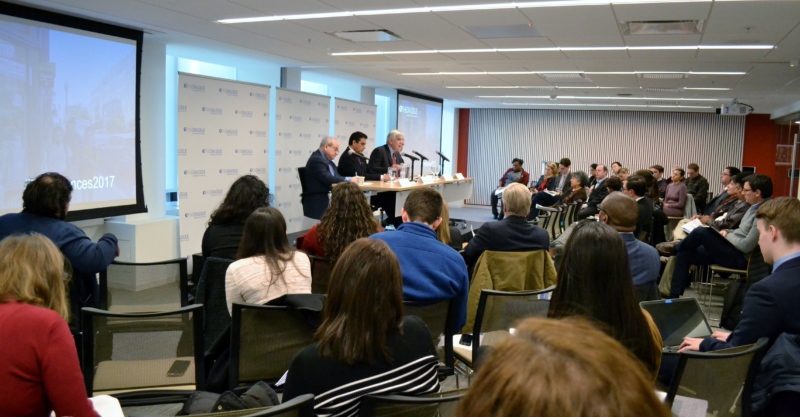Exiles are Keeping the Faith
Why do Haitians leave their homeland? How do their leaders interact with government and civic institutions in their new localities?
On January 25, 2018 the Inter-American Dialogue’s Migration, Remittances & Development Program hosted “Remittances to Latin America and the Caribbean in 2017,” an annual event presenting remittance flows to the region. Named after the most recent report written by Manuel Orozco, Senior Fellow and Program Director, the event presented the report’s main findings on migration and remittance flows to Latin America and the Caribbean in the past year. The event was moderated by the Dialogue’s President, Michael Shifter, with featured speakers Manuel Orozco, Leon Isaac (Chief Executive Director, Developing Markets Associates), and Paul Dwyer (Chief Executive Officer, Viamericas). The panel discussed the significance of the report’s findings and important political, economic, and social implications.
"There is an increase of over 8% in remittances in 2017 compared to 2016 despite significant challenges in inter-American relations." @manuelorozco65 #Remittances2017
— The Inter-American Dialogue (@The_Dialogue) January 25, 2018
Manuel Orozco began the discussion by presenting and elaborating on key findings from the report. Remittances to Latin America and the Caribbean experienced a notable increase in 2017, reaching US$75 billion, an 8% increase from the total amount in 2016. This growth was the result of several factors, including an increase in migration, migrants sending remittances more frequently, migrants sending remittances of higher amounts, and/or a combination of the three. As Paul Dwyer remarked, “If you stop to reflect on the relatively tiny size of the individual transactions and the enormous size of the aggregate transactions, what’s in the middle of that is a very, very large number of people that have made a fundamental decision on how they organize their lives and how they sacrificed for their families.”
The ways in which migrants send these remittances are important as well. Mobile and web technologies have grown in use for remittance sending and receiving, from 1% of the methods used ten years ago to 9% in 2017. Leon Isaacs, providing comparisons with the remittance landscape in Europe, discussed how even though only 9% of remittance senders use mobile transactions, this technology has the potential to save 50% of their money from high transfer fees normally seen in cash transactions.
“Factors that explain aggregate increase in remittances: increased demand for labor in US and unstable governance in the hemisphere. It is not in the national interest of the US to disrupt these remittance flows.” - Paul Dwyer @Viamericas pic.twitter.com/Ydgt5NIW9K
— The Inter-American Dialogue (@The_Dialogue) January 25, 2018
A particular pattern of migration to note, based on the report, is the increase of Haitian migration to Latin American countries such as Chile and Brazil. With 2 million Haitians living abroad, the country experienced one of the highest growth levels of remittances in the Latin American and Caribbean region. In 2017, remittances increased by 15% and made up 33.6% of the country’s GDP. The panelists discussed how other countries, especially those in Central America, have seen large waves of migration and flows of remittances in the past year as well. Some of the major push factors have been violence and political instability, particularly in the Northern Triangle of Central America and in Venezuela, while pull factors have included economic prosperity. The economic pull for migrants is particularly true for those seeking to enter the United States, as the country has been experiencing a healthy economy with high labor demand.
In regards to recent debates over migration policies in the United States, the panelists agreed that both sending back large numbers of immigrants to their home countries, as is the intent with the Trump Administration’s ending of the Temporary Protective Status program (TPS), and implementing a tax on remittances would be detrimental for migrants, their home countries, and the economy of the United States. Moving forward, it will be important for those involved in the remittance industry to continue engaging with national and international policymakers to generate informed political decisions for remittances and immigration.
Why do Haitians leave their homeland? How do their leaders interact with government and civic institutions in their new localities?
What do the election results mean for hemispheric policy and foreign relations?
The earthquake in Haiti has exacerbated an existing distress during the international recession and increased uncertainty of what to do and how to help.
 Laura Porras / Inter-American Dialogue
Laura Porras / Inter-American Dialogue